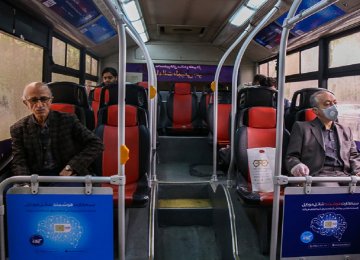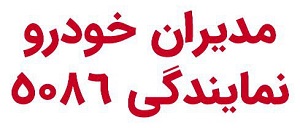Covid-19 Pushes Tehran Public Transport Toward Bankruptcy

People October 17, 2020 19:52 0 Covid-19 Pushes Tehran Public Transport Toward Bankruptcy Tehran Metro and Tehran Bus Company have been facing a cash crunch since the US sanctions were reinstated in 2018, but the spread of coronavirus has lent another blow to the sector and inflicted a loss of $15.52 million on the two …
People October 17, 2020 19:52 0 Covid-19 Pushes Tehran Public Transport Toward Bankruptcy Tehran Metro and Tehran Bus Company have been facing a cash crunch since the US sanctions were reinstated in 2018, but the spread of coronavirus has lent another blow to the sector and inflicted a loss of $15.52 million on the two companies  . . . . .
. . . . .
Economic constraints and Covid-19 have taken a toll on Tehran public transportation, as they push the sector to the verge of bankruptcy, the head of Tehran City Council’s Transportation Commission said.
Mohammad Alikhani added that Tehran Metro and Tehran Bus Company have been facing a cash crunch since the US sanctions were reinstated in 2018, IRIB reported.
“The spread of the novel coronavirus has lent another blow to the sector, shrinking the number of public vehicle passengers and inflicting a loss of 5 trillion rials ($15.52 million) on the two companies,” he said.
“Over 60% of buses working in Tehran are privately-owned and they will stop working if their operations have no economic justification.”
The official noted that negotiations are underway to increase public transportation fare by 25% for the second time in the current Iranian year (started March 20).
“Although rising prices can be discouraging to the public and might further shrink the number of passengers, the best-case scenario is that the measure will earn 500 billion rials [$1.55 million] for the transportation sector by the end of the year [March 2021], which is barely sufficient to solve any problem,” he said.
Alikhani believes that it is unfair to blame the mismanagement of officials and the worsening state on the general public.
Speaking to reporters, Mahmoud Tarfa, the head of Tehran Bus Company, said challenges facing public transportation are not a new story.
“Tehran’s buses were already insufficient and dilapidated, and unable to provide a decent transport service to citizens. More than half of Tehran buses are over 12 years old and every day more than 300 buses break down due to technical flaws,” he said.
Tarfa added that the outbreak of the lethal coronavirus has added to the problems, as the bus fleet’s daily travels have reduced from 1.8 million to less than 700,000.
“Bus drivers are not even recovering earn their expenses,” he said.
Pointing to the fact that the government has overlooked the sector for the past decade, Tarfa said, “We should wait and see if the government officials will eventually give support to the public transport system by the end of current year.”
Losses in the Capital
Three months after the Covid-19 entered the country, Tehran City Council announced that the city’s public transportation incurred a big loss of 1.2 trillion rials ($3.7 million) per month.
Late May, Alikhani had said that with the spread of the viral disease, a majority of people opt for private vehicles over public means of transportation for daily commutation.
"Normally, the public transport system handled over five million travels a day. The figure has shrunk to less than one million these days, hurting the livelihood of bus and taxi drivers," he said then.
“Cab and bus fleets operate with a lot of empty seats, as only 40% of their capacity are utilized. This is while most vehicles on the road are being used for purposes like shopping.”
Alikhani noted that social distancing is ignored in public places such as malls, emphasizing that the problem should be solved as soon as possible.
Social distancing, or remaining at least a meter and a half apart from other people, is considered the most effective way of controlling and cutting the coronavirus infection chain.
To achieve this objective, the government keeps encouraging people to stay home and use private cars for commuting, if they have to.
However, some challenges have emerged ever since, including a huge loss of income for the public transportation system, including taxis, buses and the subway.
The loss of revenue should be added to the extra expenditure spent on disinfectants and protective items used in the fleet.
Hazardous Vehicles
Talks of using the idle capacity of public transportation have raised concerns over the high risk of contamination in public vehicles.
Yousef Hojjat, the head of Tehran Municipality’s Transportation and Traffic Organization, said a large number of people who do not own a private car inevitably take a bus or taxi, or use the subway, to get to work.
“Keeping a reasonable distance between passengers becomes almost impossible when the number of passengers cannot be controlled," he said.
“The virus is still spreading and infecting people in the city and the situation has deteriorated. The resumption of social activities can make it tough to handle mortalities related to the disease.”
Similarly, Mohsen Hashemi, the chairman of TCC, underlined the warnings of Health Ministry and professionals over the risk of contamination in the use of public means of transportation.
“Public vehicles are more polluted compared to universities and schools, so extra care should be taken by citizens using them,” he added.
Adding to his concerns, Hashemi said the ventilation system of subway trains is concentrated, which means that the air in wagons is constantly circulating and combining with the air outside the train.
“This means one infected person in a train car can potentially pollute the air in all cars,” he added.
Hashemi noted that social distancing is almost impossible in a crowded city like Tehran unless more buses, taxis and train cars are added to the public transportation fleet.
Iran reported the virus outbreak in mid-February, which has so far taken the lives of 29,870 people out of a total of 522,387 infected people.
According to Iran’s Health Ministry, 420,910 patients have so far recovered from the disease.
Iran Transport NewsCoronavirus in Iran . . . . https://financialtribune.com/node/105752Click to copy the urlCopied . Republishing Guidelinessorce
برچسب ها :
ناموجود- نظرات ارسال شده توسط شما، پس از تایید توسط مدیران سایت منتشر خواهد شد.
- نظراتی که حاوی تهمت یا افترا باشد منتشر نخواهد شد.
- نظراتی که به غیر از زبان فارسی یا غیر مرتبط با خبر باشد منتشر نخواهد شد.



ارسال نظر شما
مجموع نظرات : 0 در انتظار بررسی : 0 انتشار یافته : 0